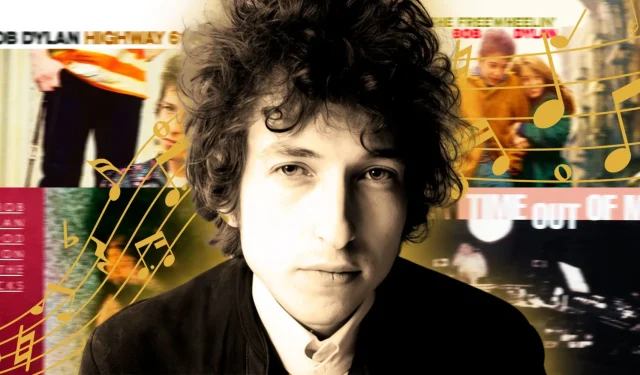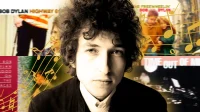The premiere of A Complete Unknown introduces a new generation of Bob Dylan enthusiasts who may feel overwhelmed by the vastness of his discography. Timothée Chalamet’s impressive portrayal touches on only a fraction of Dylan’s life, focusing on his early experiences in the 1960s Greenwich Village folk scene and his bold transition to electric music. This glimpse merely scratches the surface of the multifaceted career of one of music’s most influential figures, whose work encompasses blues, folk, and rock across several distinct eras. With such a rich history, opinions about Dylan’s best albums are as varied as his musical styles.
Listeners often find themselves divided between appreciating Dylan’s earlier, stripped-down folk albums and his later, more experimental works from the 1960s that embrace a surreal, stream-of-consciousness approach. Some argue that the pinnacle of Dylan’s poetic prowess emerged in the 1970s, while others advocate for the raw emotive power present in his 21st-century recordings. An artist who has constantly evolved and remained significant for over six decades, Dylan’s musical legacy stands among the greatest ever created.
10 Oh Mercy (1989)
Bob Dylan had a major career comeback with his 26th studio album
https://www.youtube.com/watch?v=oq7EM8jjNUshttps://www.youtube.com/watch?v=oq7EM8jjNUs
After experiencing a series of disappointing releases throughout the 1980s, many of Bob Dylan’s loyal followers began to question his relevance. The release of Oh Mercy in 1989 marked a significant resurgence for the artist, thanks in part to his collaboration with producer Daniel Lanois. This album sidestepped the uninspired production oversaturation of its predecessors, like Empire Burlesque and Down in the Groove, and showcased a compelling return to form that demonstrated Dylan still had vital themes to explore.
The opening track, “Political World,” reignited Dylan’s reputation for protest music while “Most of the Time” offered a nostalgic introspection reminiscent of his earlier work. It was clear that Dylan’s creative juices had been revitalized, likely influenced by his involvement with the supergroup Traveling Wilburys the previous year. Oh Mercy laid the groundwork for a series of late-career successes, reinforcing Dylan’s ability to transcend creative ruts.
9 John Wesley Harding (1967)
Bob Dylan got back to his folk roots with his eighth studio album
https://www.youtube.com/watch?v=bT7Hj-ea0VEhttps://www.youtube.com/watch?v=bT7Hj-ea0VE
Recorded concurrently with the legendary The Basement Tapes, his collaboration with The Band, John Wesley Harding marked a return to simpler folk influences after the rock excesses of preceding albums. This album, with its focus on grounded lyrics and vivid imagery, represented a clearer poetic style compared to the surrealism of Blonde on Blonde. Following his recovery from a motorcycle accident, this project reflected Dylan’s efforts to strip back and rediscover his core artistic voice.
Despite a spelling error in the album’s title—”John Wesley Harding”misspelling the infamous outlaw John Wesley Hardin—this album delivered tremendous insight into Dylan’s evolving artistry. While “All Along the Watchtower” gained widespread acclaim, particularly through Jimi Hendrix’s iconic cover, the record held a multitude of profound reflections. Tracks like “The Ballad of Frankie Lee and Judas Priest” delve into existential questions, showcasing a more introspective Dylan compared to the chaotic intensity of his earlier work.
8 The Times They Are A-Changin’ (1964)
Bob Dylan fully embraced protest music on his third studio album
https://www.youtube.com/watch?v=90WD_ats6eEhttps://www.youtube.com/watch?v=90WD_ats6eE
While many regard Bob Dylan as a protest singer, this label only encapsulates a short segment of his career best defined by The Times They Are a-Changin’. This 1964 release features incisive political anthems tackling issues of racism, poverty, and social reform, earning Dylan recognition as a voice for the progressive youth of his time. The title track serves as a timeless rallying cry for change.
Other standout tracks such as “With God on Our Side” and “The Lonesome Death of Hattie Carroll”showcased Dylan’s extraordinary talent for distilling complex societal critiques into poignant folk songs that resonate across generations. While undeniably his most politically charged album, The Times They Are A-Changin’ also reveals glimmers of the romantic introspection exhibited in The Freewheelin’ Bob Dylan through songs like “Boots of Spanish Leather.” Combining rich character dynamics with raw emotion, these tracks foreshadowed his future literary acclaim, including the Nobel Prize in Literature.
7 Rough And Rowdy Ways (2020)
Bob Dylan proved he’s sharp as ever with his 39th studio album
https://www.youtube.com/watch?v=3NbQkyvbw18https://www.youtube.com/watch?v=3NbQkyvbw18
In 2020, Bob Dylan once again cemented his legacy with the unexpected release of Rough and Rowdy Ways, an album that felt like a monumental event. Kicking off with “Murder Most Foul,” a sprawling near-17-minute exploration of America’s modern history through the lens of the Kennedy assassination, the track showcases Dylan’s sharp lyrical prowess and biting wit. The ethereal beauty inherent in this song sets the tone for an album bursting with extraordinary depth and resonance.
Whether or not Rough and Rowdy Ways will serve as Dylan’s final studio offering remains uncertain, but it certainly encapsulates the writer’s timeless ability to connect with listeners. Songs like “I Contain Multitudes”and “False Prophet” reflect on his storied life and legacy, framing Dylan as a seasoned performer channeling his experiences with an intimate audience. With this release, Dylan has once again proven that his artistic prowess remains undiminished.
6 Time Out Of Mind (1997)
Bob Dylan looked mortality in the eye with his 30th studio album
https://www.youtube.com/watch?v=BxDU9Q2RDBchttps://www.youtube.com/watch?v=BxDU9Q2RDBc
Time Out of Mind, released in 1997, emerged during a period where many believed Dylan was contemplating the closure of his artistic journey. The album, infused with a haunting ambiance and confronting themes of mortality, marked a new artistic phase where Dylan grappled with profound subjects like death and existence. On tracks such as “Tryin’ to Get to Heaven”and “Not Dark Yet,”Dylan transmits a sense of wisdom shaped by experience.
Commercially, the album also thrived, introduced to a wider audience through “Make You Feel My Love,”a poignant love anthem covered by various artists, including Adele. The album closes with the brilliant 16-minute track “Highlands,” which transports listeners to otherworldly realms. As a reunion with long-time collaborator Daniel Lanois, Time Out of Mind also marked the end of Dylan’s collaborations with non-self-produced projects.
5 The Freewheelin’ Bob Dylan (1963)
Bob Dylan truly found his voice on his second studio album
https://www.youtube.com/watch?v=1iHhWh9FtsQhttps://www.youtube.com/watch?v=1iHhWh9FtsQ
While Bob Dylan made his debut in 1962, it was with the release of The Freewheelin’ Bob Dylan in 1963 that his prodigious songwriting prowess truly came to light. This album featured almost exclusively original compositions, showcasing a younger artist with a voice mature beyond his years. Every song contributed to a new legacy that continues to shape modern indie folk, establishing a foundational text for countless aspiring singer-songwriters.
Beginning with the iconic “Blowin’ in the Wind,”which encapsulated Dylan’s role as a generational spokesperson in just three minutes, the record also includes intimate tracks like “Don’t Think Twice, It’s All Right.”As he navigated complex topics through songs like “Masters of War”and “A Hard Rain’s a-Gonna Fall,”The Freewheelin’ Bob Dylan solidified his position as the benchmark for artistic excellence in the 1960s music scene.
4 Bringing It All Back Home (1965)
Bob Dylan shocked the folk scene by going electric on his fifth studio album
https://www.youtube.com/watch?v=MGxjIBEZvx0https://www.youtube.com/watch?v=MGxjIBEZvx0
Bringing It All Back Home, released in 1965, was a transformative moment in music history, marking Dylan’s daring departure from folk conventions. This landmark album is divided into two sides: the first side is electrifying, fast-paced rock songs while the second reverts to his acoustic roots. This dichotomy signified not only musical evolution but also a departure from overt protest themes towards more opaque, poetic lyricism.
Opening with “Subterranean Homesick Blues,”the album launched a new persona for Dylan—one characterized by an anti-establishment punk rock ethos and complex lyrical narratives exemplified in tracks like “Maggie’s Farm”and “It’s Alright, Ma (I’m Only Bleeding).”Bringing It All Back Home established Dylan’s capacity to express vigor and artistic diversity, pushing the boundaries of folk music and welcoming new rock elements.
3 Blonde On Blonde (1966)
Bob Dylan leaned fully into a surreal, stream-of-consciousness style on his seventh studio album
https://www.youtube.com/watch?v=0c1NJPCN6nAhttps://www.youtube.com/watch?v=0c1NJPCN6nA
The mid-1960s were a prolific era for Bob Dylan, culminating in the monumental double album Blonde on Blonde, which delves deeply into surrealistic lyricism and stream-of-consciousness narrative techniques. Alongside Highway 61 Revisited, this album forms part of an unmatched trilogy of creativity that shaped the era. Blonde on Blonde encapsulates the essence of Dylan’s most experimental period before he embraced a more simplified approach with John Wesley Harding.
Initiated by the playful “Rainy Day Women #12 & 35,”and containing unforgettable love songs such as “I Want You”and “Just Like a Woman,”this record displays a poet at his zenith. However, the crowning achievement lies within the enigmatic “Sad Eyed Lady of the Lowlands,”a track rich with literary allusions that invites interpretation, showcasing Dylan’s capacity for complex emotional expression.
2 Highway 61 Revisited (1965)
Bob Dylan broke new ground with his sixth studio album
https://www.youtube.com/watch?v=IwOfCgkyEj0https://www.youtube.com/watch?v=IwOfCgkyEj0
Kicking off with the iconic “Like a Rolling Stone,”Bob Dylan’s album Highway 61 Revisited set a benchmark for artistic excellence. This record captures why Dylan remains a revered figure in music, as each song brimming with philosophical depth, complexity, and cleverness showcases his skill at the peak of his powers. It’s an essential listen for anyone seeking to understand his mesmerizing artistry.
From “Ballad of a Thin Man,”which satirizes media perceptions, to the spiritually infused title track, the album exemplifies Dylan’s ability to capture profound insights into modern life through Biblical imagery long before his later spiritual explorations. Ultimately, Highway 61 Revisited embodies the essence of Dylan’s lasting influence during the 1960s.
1 Blood On The Tracks (1975)
Bob Dylan laid his soul bare on his 15th studio album
https://www.youtube.com/watch?v=QKcNyMBw818https://www.youtube.com/watch?v=QKcNyMBw818
Amid personal turmoil in 1975, including his crumbling marriage and creative challenges, Bob Dylan produced Blood on the Tracks, widely acclaimed as his greatest work. This album, rich in emotion and intimate storytelling, is often regarded as one of the finest breakup albums ever recorded. Dylan’s turmoil with his then-wife Sara significantly colored the album’s reflective narratives—each song reads like beautifully woven short stories.
Though Dylan downplayed the autobiography of the album, he indicated that the opening track, “Tangled Up in Blue,”required “ten years to live and two years to write”(via Time). Blood on the Tracks represents Dylan’s most mature effort to date, showcasing a man committed to revealing his inner self to the world. The album’s ageless appeal resonates with listeners through various life stages, solidifying its lasting legacy.
Source: Time


